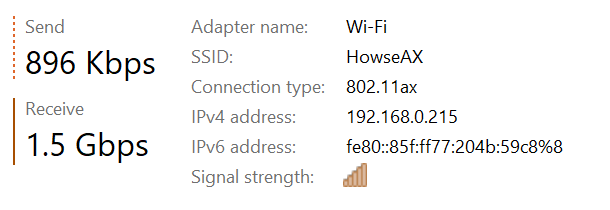AT 101: Wi-Fi 6 And Why You Want It
by Brett Howse on February 12, 2020 8:00 AM ESTTo The Future
If the question is do you need Wi-Fi 6, the answer is most assuredly “maybe”. The performance improvements are substantial, but really rely on a very strong signal to get the most data throughput. Most of the new features of Wi-Fi 6 focus on the influx of devices to the standard, and dealing with many devices connected to the same access point, or devices trying to share spectrum when connected to different access points.
The addition of Orthogonal Frequency Division Multiple Access to the Wi-Fi 6 standard will likely be the most impactful change to this revision. It will allow access points to carve up their channels into smaller slices, allowing more devices to communicate at the same time with less overhead. Each device will lose out on peak throughput, but the reduced latency should help a lot, especially in very dense environments. It should help with excessive overhead on the network layer when multiple devices are sending many small packets at once, which is a very common scenario, especially in an office or stadium situation.
Multi-User MIMO was in the Wi-Fi 5 specification as an optional implementation, and as such it did not really take off. Wi-Fi 6 should make this more prevalent, and also adds support to the MU-MIMO on the uplink, not just the downlink side. This will increase the capacity of access points for higher-speed use cases, but MU-MIMO did not get a lot of traction in Wi-Fi 5 so we will have to see how much adoption it gets in Wi-Fi 6.
The wider 160 MHz channels will offer significantly more throughput in the home environment, as we saw in our performance tests. As with the 1024-level QAM though, to see the biggest benefit you will need a strong signal. The vast majority of home networking is still limited to 1 Gigabit Ethernet, which puts Wi-Fi 6 into somewhat of an awkward spot, since it can transfer faster than most wired home networks, but even so, that is still a significant improvement over Wi-Fi 5 which would cap out around 600 Mbps on the best Wi-Fi adapters. If you work with a lot of large files, and you prefer to use Wi-Fi instead of the more consistent, yet cumbersome Ethernet, there’s still a nice boost to be had.
The future looks strong for Wi-Fi, and the Wi-Fi Alliance has made some excellent revisions to their standard to help improve Wi-Fi for the next generation of devices. As with any standards change, the impacts will not be seen right away. Both the access point, and the client need to be leveraging the new standard for the improvements to be noticeable. We’ve already seen the latest generation of smartphones start to offer Wi-Fi 6, and there’s been some movement in the PC space as well with Intel’s Project Athena. Anyone looking at a new router today should certainly opt for a Wi-Fi 6 model, but there’s likely not a major need for most people to move from Wi-Fi 5 access points right away. If you live in a heavily congested wireless area, the advantages of features like BSS coloring and Spatial Frequency Reuse should help out in those scenarios, but for people looking at purely performance, Wi-Fi 6 somewhat runs into a wall of its own making, since it can now transfer at over Gigabit speeds on a typical 2x2:2 connection. But who are we to question performance?












149 Comments
View All Comments
PyroHoltz - Monday, February 17, 2020 - link
This was my understanding as well, AX = full duplexthomasg - Thursday, March 5, 2020 - link
802.11ax is NOT full-duplex.No practical full-duplex radio system exists at this point in time.
thomasg - Thursday, March 5, 2020 - link
You might have mistaken the use of OFDMA as multiple-acces scheme, but OFDMA does not make it full-duplex, it still is entirely and strictly half-duplex.jeads - Tuesday, April 6, 2021 - link
AX is NOT full duplex, its still half duplex. There is talk, but none that I've seen yet, of AX routers using 4x4 antenna. Most consumer routers are still 2x2 (dual band), or 3x3 (tri-band). 4x4 (quad band?), while not true full duplex, will emulate as much.Vorl - Wednesday, February 19, 2020 - link
You also forgot to mention that it's shared. your WIFI router can go 3.6gb/s, but your devices even in a perfectly isolated environment all have to share that bandwidth. You don't get 3.6gb/s to each device.Gasaraki88 - Thursday, February 13, 2020 - link
It sounds faster on paper. If you ACTUALLY look at the speed of wifi on the AC 5GHz band with 2 of the same AC routers connected to each other, it is not faster than hard wire gigabit connection. Look at some router reviews.PEJUman - Thursday, February 13, 2020 - link
this is just one of those rare inflection points (fast ethernet with 802.11n was similiar), which brought gigabit ethernet into mainstream.I have been running 10 Gb ethernet on copper, mixed cat 5e and '7' + Wifi 5 (802.11AC) network in the house for the past 4 years, if you are patient, you can find deals on 10 Gb stuff here and there. Market acceptance on 10 Gb is still quite slow, but I am hoping 5 or 2.5 Gb will be better at getting down to affordable price points.
azfacea - Saturday, February 15, 2020 - link
wow did u just compare fast ethernet to 802.11n ?? one of the most ignorant comments i have read in all of internet. u have no idea what you are talking about gigabit ethernet existed in mainstream (sub 1000$ desktop) in 1999. 802.11n wasnt in the mainstream until no less than a decade after thatPEJUman - Monday, February 17, 2020 - link
gigabit ethernet existed, but gigabit routers does not, at least not at the affordable, mainstream price point. It is not until 'n' that you get gigabit for essentially no premium.yetanotherhuman - Friday, February 14, 2020 - link
Nah, most access points only have a 1Gbit link, and latency and packet loss are always going to be shit on wifi compared to a wired connection.Also, 2.5, 5, 10 and 40 Gbps Ethernet have been A Thing for a while if you go out of your way.